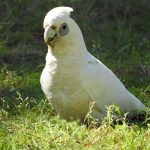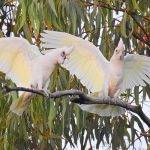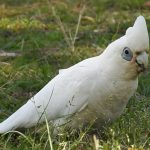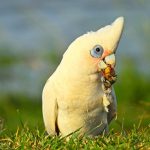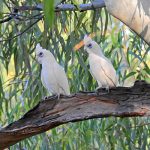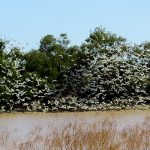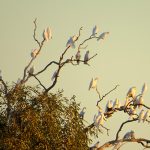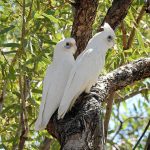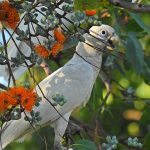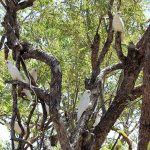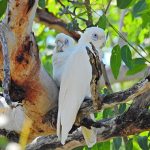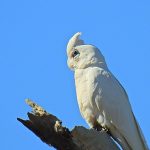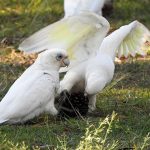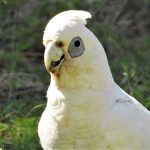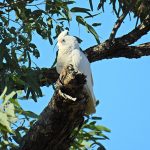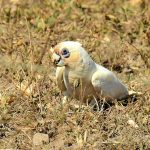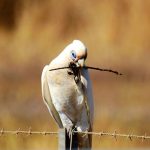LITTLE CORELLA
Playful Parrots of Australia
Early one golden morning, the sun just beginning to warm the landscape, you walk through an open park on the edge of the Australian bush. Suddenly, a raucous flood of laughter bursts from the trees above—a flock of Little Corellas. Their crisp white feathers and playful flips in the sunlight invite you into their world, where intelligence, social bonds, and wild exuberance meet.
Where They Are Found: The Spread of the Flock
Little Corellas are true travellers of the Australian continent, their flocks gathering wherever life and water flow.
- Range:
- Found throughout most of mainland Australia—especially northern, western and central regions, from the drier Outback to more open coastal plains.
- They are rare along the far eastern and southern coasts and are absent from Tasmania.
- Habitats:
- Open woodlands echo with their calls.
- Riverbanks offer nesting sites in the hollows of mature eucalypts and red gums.
- Farmlands and city parks alike provide foraging grounds, where they have adapted comfortably to living alongside people.
- Beyond Australia:
- Small populations exist in New Guinea and islands close to northern Australia, often where agriculture or settlement have provided new opportunities.
Appearance and Sensory Impressions: Closely Observed
Approach a resting flock, and you’ll find:
- Visual:
- Pure white plumage glinting in sunlight, with the faintest blush of pink beneath their beaks and around the eyes.
- A delicate blue wash surrounds their dark, intelligent eyes.
- When one bird raises its short crest, it reveals a subtle crown.
- Auditory:
- Their voices fill the air: a throaty mix of screeches, playful chatter, and sudden trills. At dusk, the murmurs of a settling flock carry through the still air.
- Tactile and Olfactory:
- Imagine soft feathers brushing fleetingly across your skin, and the fresh leaf-and-earth scent of their wild foraging grounds.
Behaviour: Sociable Acrobatics
Little Corellas live their lives in company:
- Flock Size:
- From dozens to thousands, their sheer numbers darken the sky as they wheel overhead.
- Movement:
- Tumbling through the air, hanging upside-down from wires and branches, even sliding down city roofs—they are playful by nature.
- Intelligence:
- Tool use, object puzzles, and the occasional lock-picking trick all make Corellas notorious local characters.
Breeding Habits: Life Begins in the Hollow
When the season turns—usually late winter in the south, or the dry season in the tropics—family life begins:
- Pairs form strong bonds and seek out large tree hollows, sometimes using cliffs or even man-made structures where trees are scarce.
- The nest is lined with wood chips or leaves, and both parents share the job of incubating 2–5 white eggs.
- After 24–29 days, the chicks hatch and grow swiftly, fed by attentive parents.
- By 6–8 weeks, young Corellas leave the hollow but remain with family groups, learning social skills and foraging techniques.
Why We Love the Little Corella
- Long Life:
In good conditions, they may live up to 50 years—a lifetime rich with flock memories. - Seed Dispersers:
Their feeding habits support entire ecosystems, spreading seeds and enhancing soil health. - Roosting:
Hundreds or thousands gather in communal night roosts, creating a tapestry of soft calls and movements as darkness falls. - Playful Spirits:
Their antics—sliding, somersaulting, and apparent games—speak to remarkable intelligence and curiosity. - Pop Culture and Story:
In Indigenous Australian traditions, the Little Corella is sometimes depicted as a clever, mischievous trickster, well-loved for its wit.
Conservation and Human Connection
Although Little Corellas have adapted to modern landscapes, not all encounters with people are easy. Agricultural communities sometimes see large flocks as pests, as they can damage crops or ornamental trees. Yet, their resilience and adaptability also reflect nature’s ability to cope with change.
- Conservation Status:
- Not currently threatened, classified as “Least Concern” by the IUCN.
- Role:
- Vital for healthy wild ecosystems and urban green spaces.
- Message:
- Protecting habitats—especially mature trees for nesting—supports not just Corellas but countless other species.
Quick Reference Table
| Feature | Description |
|---|---|
| Scientific Name | Cacatua sanguinea |
| Range | Most of mainland Australia |
| Habitat | Open forest, riverbanks, farmland, city parks |
| Lifespan | Up to 50 years in good conditions |
| Social Behaviour | Highly social, flocks of thousands |
| Diet | Seeds, bulbs, roots, berries, crops, urban scraps |
| Breeding Season | May–October (varies by region) |
| Nesting | Tree hollows, cliffs, sometimes man-made structures |
| Clutch Size | 2–5 eggs |
| Conservation Status | Least Concern (IUCN Red List) |
A Flock in Flight
As evening approaches and you watch a cloud of Corellas spinning above a riverbank, their calls rise into the golden sky, a chorus of playful chaos. In that moment, the Little Corella embodies the wild, unbroken energy of Australia’s natural world—a feathered presence both ancient and ever-adaptable. Through understanding and care, we can ensure these joyful flocks continue to lift our spirits, their white wings a reminder of nature’s power and resilience.
Let us watch, protect, and celebrate the Little Corella—a proud symbol of life’s adaptability, intelligence, and the beauty of living together.

